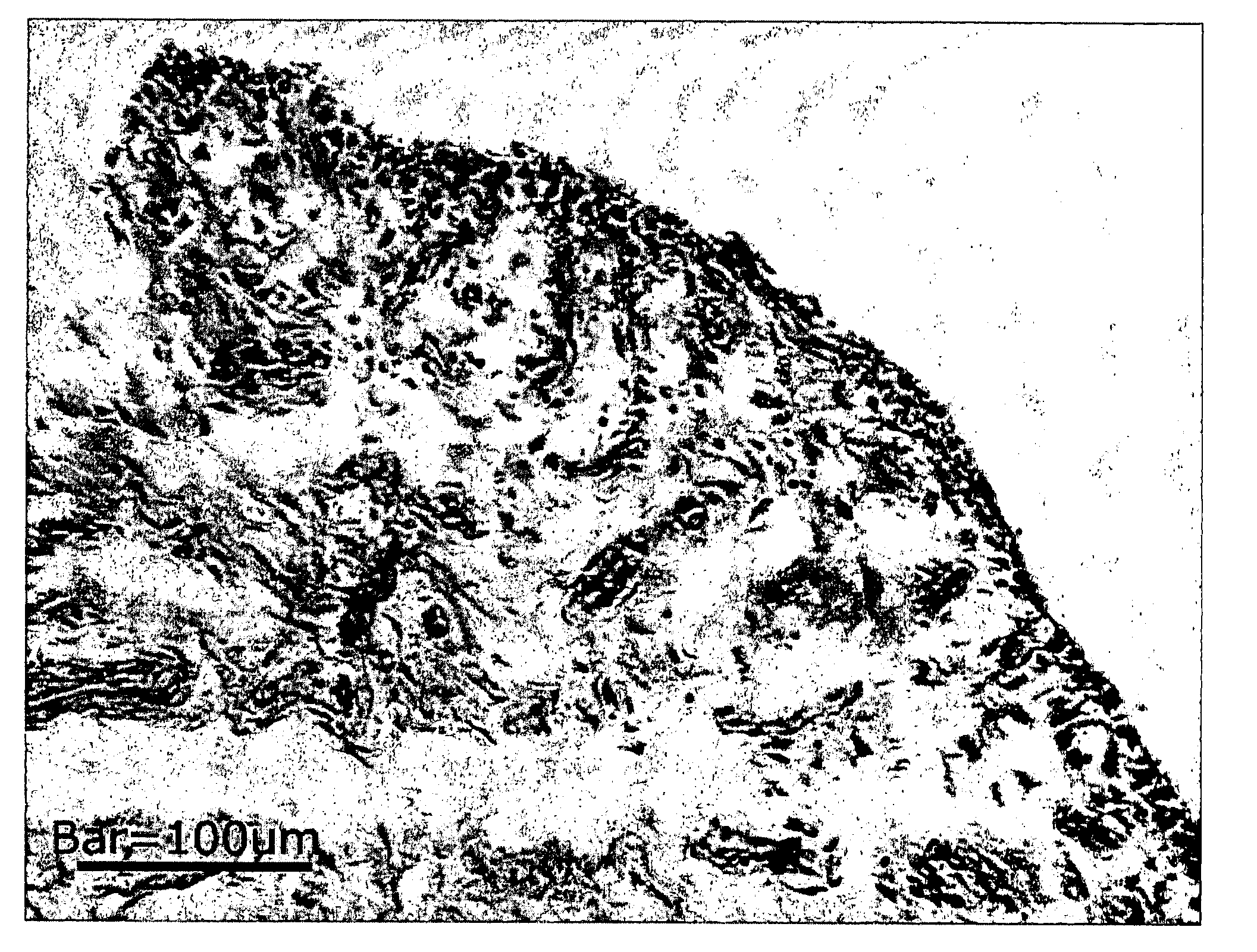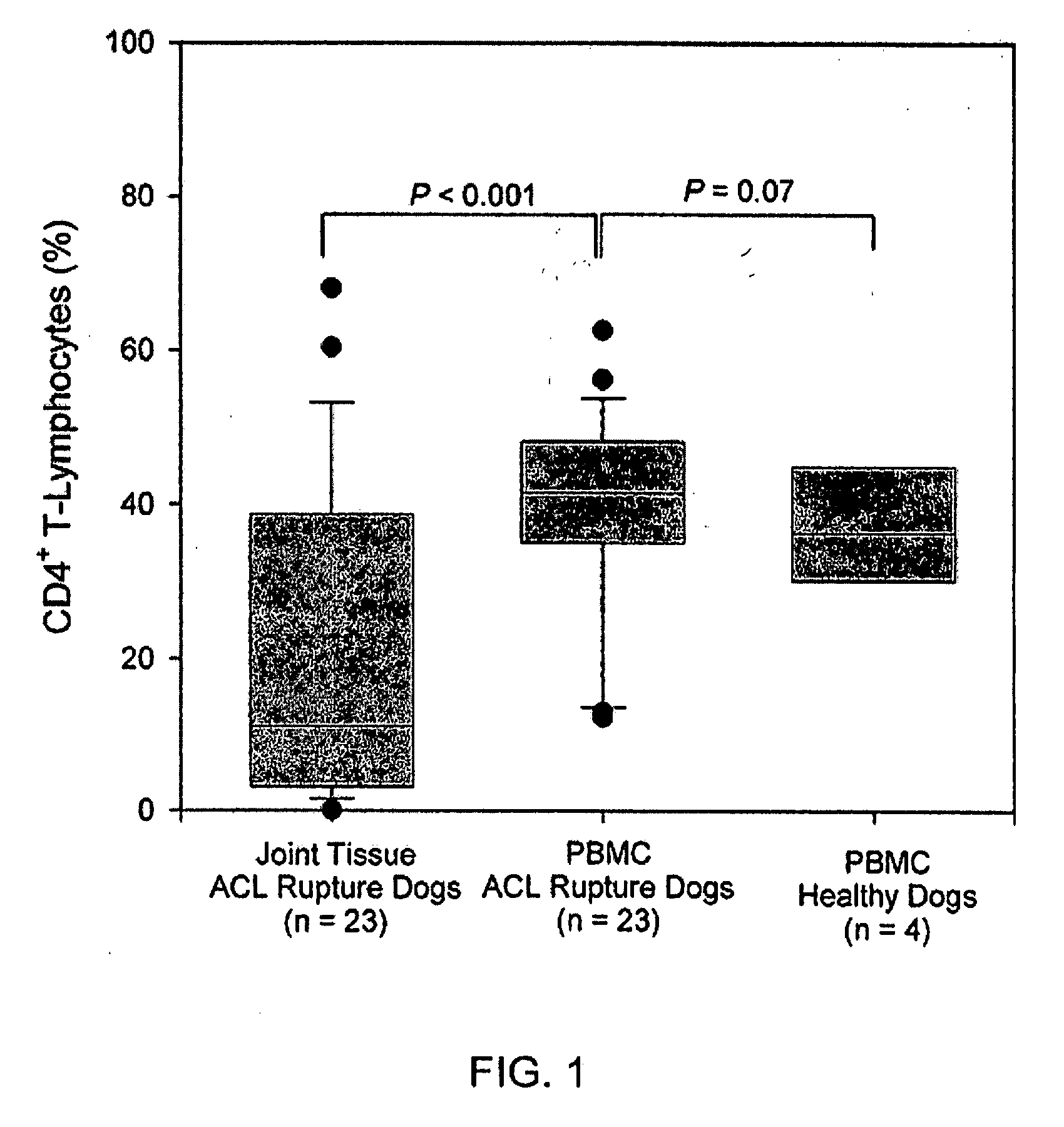Methods of diagnosing synovial disease in a mammal by detecting bacterial DNA in synovial tissues from dogs with inflammatory knee arthritis and degenerative anterior cruciate ligament rupture
a technology of synovial tissue and mammalian cells, which is applied in the field of human-made kits and methods for detecting synovial disease in the knee of a human, can solve the problems of complex interaction between bacteria and the host immune system, unrecognized specific mechanism involving bacterial triggering of joint inflammation, and inability to detect bacterial dna in synovial tissues,
- Summary
- Abstract
- Description
- Claims
- Application Information
AI Technical Summary
Benefits of technology
Problems solved by technology
Method used
Image
Examples
example 1
[0120] Blood and Joint Tissue Samples. Peripheral blood and specimens of synovium and ruptured ACL were collected from 23 dogs with inflammatory stifle arthritis / degenerative ACL rupture during surgical treatment. Peripheral blood samples were also collected from 4 healthy dogs with normal stifles. Procedures were conducted with the approval of the Animal Care Committee of the University of Wisconsin-Madison.
[0121] Preparation of PBMC for Flow Cytometry. PBMC were isolated using commercial cell separation tubes being BD Vacutainer™ CPT™, Becton Dickinson, Franklin Lakes, N.J.
[0122] After washing in phosphate buffered saline (PBS), erythrocytes were lysed. PBMC was then washed in RPMI with 10% fetal calf serum (RPMI / FCS). After determining the concentration of cells, cell counts were adjusted to ≦1×107 / ml using FACS buffer. PBMC were then blocked and stained with fluorochrome-labeled anti-canine monoclonal antibodies directed against CD3, CD4, CD8, and CD44 epitopes, Serotec, Ralei...
example 2
[0142] Both synovial fluid and synovial membrane specimens were collected at surgery from a further 51 dogs with inflammatory stifle arthritis / degenerative ACL rupture. Dogs with PCR-positive joints were treated with doxycycline at 5 mg / kg bid orally for 10 weeks. Follow-up synovial fluid specimens were then collected aseptically by percutaneous needle aspiration.
[0143] Specimen collection and PCR for Bacterial DNA. Experiment #1. Synovial membrane specimens were collected aseptically during surgery. For the initial experiment, after extraction of DNA, a non-nested broad-range panbacterial PCR method was used for detection of DNA from the bacterial 16S rRNA gene. The PCR system used consensus primers for a highly conserved region of the gene. (Gerard H C et al., 2001).
[0144] All PCR reactions were performed in a laminar flow hood and extensive precautions were taken to prevent contamination of the PCR system. PCR products were examined under UV light after electrophoresis on a 1.5...
example 3
[0161] Blood and Joint Tissue Samples. Peripheral blood, synovium, and the ruptured ends of the CCL, when available, were collected from 23 dogs with stifle oligoarthritis and associated degenerative CCL rupture during surgical treatment. Age, weight, and gender were recorded for each dog. Peripheral blood and synovial tissues were also collected from 6 normal beagles with healthy stifle joints as a baseline for comparison with the dogs with oligoarthritis. The Beagles were all female; body weight and age were 10.5±1.7 kg and 3.3±3.0 years. Peripheral blood samples were also collected from five young healthy dogs of other breeds (Airedale Terrier, Pitbull Terrier, Toy Poodle, Gordon Setter and Boxer). The age and weight of these dogs were 21.5±9.8 kg and 1.5±1.4 years.
[0162] Preparation of Peripheral Blood Mononuclear Cells (PBMC) for Flow Cytometry. PBMC were isolated using commercial cell separation tubes (BD Vacutainer™ CPT™, Becton Dickinson, Franklin Lakes, N.J.). After washin...
PUM
| Property | Measurement | Unit |
|---|---|---|
| Electrical conductance | aaaaa | aaaaa |
| Concentration | aaaaa | aaaaa |
| Degradation properties | aaaaa | aaaaa |
Abstract
Description
Claims
Application Information
 Login to View More
Login to View More - R&D
- Intellectual Property
- Life Sciences
- Materials
- Tech Scout
- Unparalleled Data Quality
- Higher Quality Content
- 60% Fewer Hallucinations
Browse by: Latest US Patents, China's latest patents, Technical Efficacy Thesaurus, Application Domain, Technology Topic, Popular Technical Reports.
© 2025 PatSnap. All rights reserved.Legal|Privacy policy|Modern Slavery Act Transparency Statement|Sitemap|About US| Contact US: help@patsnap.com



